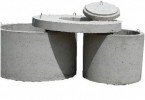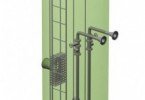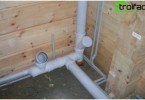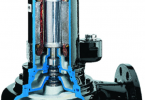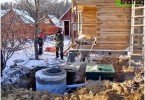When planning the construction of a cozy country house or cottage in an area where there is no possibility of connecting to the central sewage system, special attention should be paid to such a problem as the organization of autonomous drainage. An effective purification system can not only make suburban life as comfortable as possible, but also solve the problem of environmental pollution. And it will help in the implementation of the conceived septic tank for giving – a device for collecting and treating wastewater.
Content
- Classification of septic tanks for a summer residence: pros and cons
- Storage septic tanks: specifics
- Expediency of treatment septic tanks
- Septic tanks made of steel
- Cons and pros of reinforced concrete structures
- Plastic septic tanks are leaders
Classification of septic tanks for a summer residence: pros and cons
Septic tanks are equipment designed to collect and purify human waste products. Modern septic tanks can be conditionally divided into treatment and storage.
Storage septic tanks: specifics
Such septic tanks are also called cesspools. They are reservoirs for collecting contaminated water. Impurities gradually settle to the bottom, and tertiary treatment is carried out either in specialized containers or in a natural way (when passing through soil layers).
Cesspools are characterized by affordable price and ease of use. The main disadvantage is the need for systematic purification (at least 1 time in 3 months), carried out by a cesspool machine. Such a cleaning system is acceptable for cottages that are not suitable for long stays..
Expediency of treatment septic tanks
For cottages where residents regularly use water supply, they bathe in a bathhouse and take a shower, it is more advisable to install a septic tank for giving without pumping, which easily processes a large volume of water and will not create inconvenience with emptying the tank.
The service life of a septic tank largely depends on the quality of the material used in its production. In accordance with this parameter, the types of septic tanks are distinguished:
Septic tanks made of steel
Stainless steel is the least suitable material for treatment systems, as has many disadvantages. Septic tanks made of stainless steel are heavy, costly and difficult to install, amenable to corrosion, which means they are short-lived.
Cons and pros of reinforced concrete structures
Along with the main drawback – significant weight, they have positive features. The composition of reinforced concrete includes substances that increase hygroscopicity; septic tanks made of concrete are reliable, do not float, such as plastic counterparts.
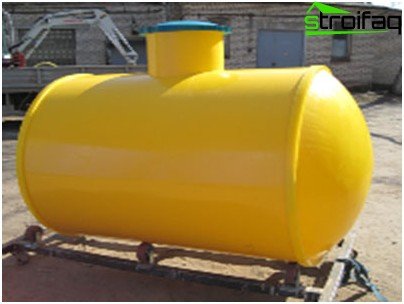
Plastic septic tanks are leaders
Lightweight plastic septic tank for gardening is easy to install and transport, easy to maintain, reliable in operation
Leaders in popularity. They are lightweight, easy to install, durable and inexpensive. The only problem is the possibility of floating, so during installation you need to attach a reinforced concrete slab to the septic tank made of plastic.
Functional principle of a septic tank
The principle of the septic tank, regardless of the variety, looks like this.
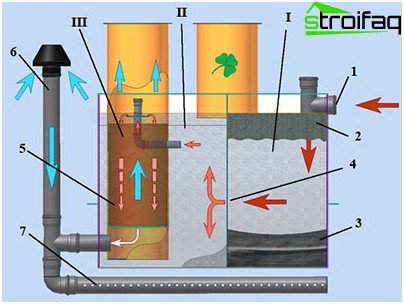
Septic tank for giving: the principle of work
Through the inlet pipe (1), the waste water enters the chamber (I), where the primary separation of the waste products takes place. In this case, the substances are divided into those whose specific gravity is less than that of water, i.e. they emerge (2) and on those whose weight is greater, i.e. they settle (3). Due to the fact that overflow (4) into the next chamber (II) occurs at the level of 1/3 of the drive height, there will be less impurities in the second tank.
In the second chamber, the separation process continues, with the difference that the second tank is aimed at components that were supposed to precipitate, but accidentally slipped during the sedimentation process. In addition to mechanical separation, anaerobic (oxygen-free) fermentation with the release of methane occurs in the first two tanks. The cameras are closed by a water shutter, which eliminates the appearance of an unpleasant odor.
The third chamber (III) is a fine filter, functioning as follows: the components that have passed the previous two stages settle on the surface of the aggregate, for example, expanded clay (5). But the matter is not limited to physical cleaning. Unlike the first two tanks, the third is not filled with water: it is blown with air. Here, aerobic bacteria (in need of oxygen) eat the precipitate, turning it into vinegar and CO 2.
Business Continuity
- 2 times a year, the device is cleaned of sediment with the help of a sewage system;
- after 10 years it is necessary to wash / replace the filtration field, which eventually becomes clogged with sludge. 40 m3 of sand, soil and gravel should also be replaced..
How to choose a septic tank for a summer residence
When deciding which septic tank to choose for a summer residence, consider 2 important points.
1. Volume. The indicator is calculated from the average daily water consumption. Suppose a family of 4 lives in a cottage, each of which consumes an average of 200 liters of water per day, for 3 days the family will use 2,400 liters, so the volume of a septic tank should be at least 2.5 m3.
It is important! The volume of the septic tank should be 3 times greater than the daily volume of wastewater.
If the cottage has a minimum of plumbing fixtures (a bathroom and a washbasin), then the daily water consumption will be less.
2. The strength of the structure. This indicator depends on the wall thickness, the presence of stiffeners and the material from which the septic tank is made. The best option is polypropylene, PVC or fiberglass.
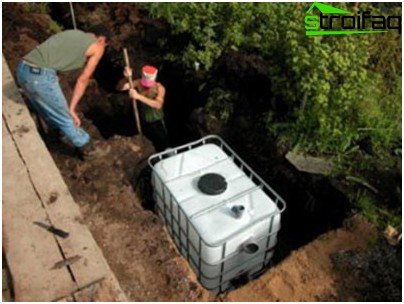
Do-it-yourself septic tank
It’s easy to make a similar septic tank for giving with your own hands
A septic tank for a summer residence can be made independently, it is enough to enlist patience and relevant knowledge.
Regulatory layout
Septic tank is installed at a distance of not less than 5 m and not more than 15 m from the foundation of the cottage.
It is important! If, nevertheless, the distance is planned to be more than 15 m, then between the house and the septic tank it is necessary to install a revision (intermediate) well.
Do not forget about the need for periodic maintenance, so when choosing a place, consider the possibility of access to the sewer system. Details of the location standards are presented below..
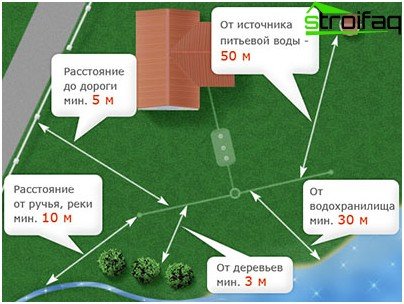
Norms for the location of a septic tank for a summer residence
Installation tips
1. The pipeline to the septic tank should be straight, without bends. If laying a direct pipeline is not possible, then in the places of bends, rotary wells are mounted.
It is important! The slope of the pipeline must be at least 20 mm / linear meter. Reverse bias not allowed.
2. The cottage septic tank must be installed on a sand cushion 30 cm thick. To impart stability (during installation), fill the drive up to half with water and seal the sand layer between the supports.
3. If the summer cottage is located in an area with high groundwater, the septic tank on a concrete slab should be secured with lashing straps..
4. It is better to fill the foundation pit with a septic tank not with the removed soil, but with fine sand. Filling should be carried out layer by layer with ramming layers. If the depth is not deep enough, the septic tank and pipeline are insulated with expanded clay or slag.
Progress and sequence of work
The basis for the septic tank will be 2 Eurocubes with a volume of 800 liters each. It should immediately be noted that the system works safely both in summer and in winter, without creating difficulties during operation. The only need is regular backfill of bacterial preparations to prevent odor.
It is important! Do not forget to put tees on all the ends of the pipes – this will save from clogging with surface-active substances: soap, shampoo, detergents.
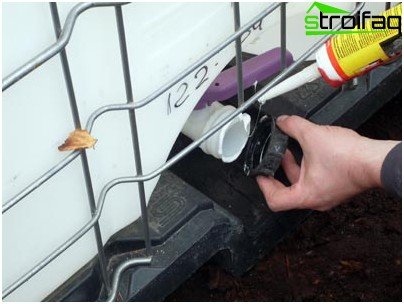
Drain sealing is a prerequisite for proper installation
We seal the drain of Eurocubes. If the neck for tees is small – we increase the opening with the help of a cutting machine. Bend the edge and find out if the tee passes. If there is no short pipe at hand, then cut the long one, and then process the edges (in the place of the planned sewer pipe from the house).
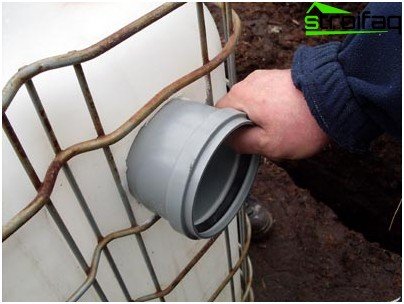
Sewer pipe insert
We insert a short part of the sewer pipe. From the inside we connect a tee and communicate the pipes to each other. A hole 50 mm in diameter should be cut above the tee (for ventilation pipe). Next, cut a hole for connecting the tanks.
It is important! The connecting pipe should be lower than the inlet.
The edges are trimmed. For cutting holes, a cutter with a diameter of 110 mm can be used..
Tanks need to be displaced relative to each other by 20 cm. This is necessary to maximize the potential of the second tank. Note that connecting pipes also need a tee with ventilation outlets..
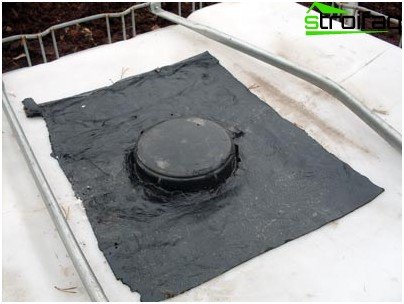
Waterproofing layer
We seal pipes with silicone. We weld the tank frame and strengthen it with fittings. We fix the walls in place of the technological seam with rivets. We put a layer of waterproofing in place of the seam.
It is important! Immediately after installation in the ground, regardless of whether you will fill the eurocube with concrete, the septic tank must be filled with water.
After the treatment plant is lowered into the pit, it is necessary to lay a profiled sheet on the outer frame or pour concrete on the sides of the septic tank. Concreting will prevent ascent of the septic tank when soil is heaving.
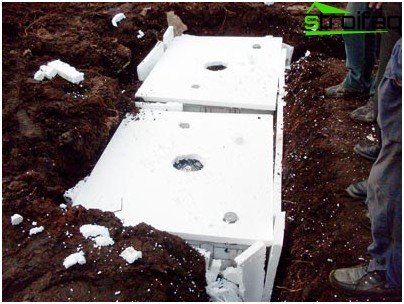
Foam insulation
From above and from the sides, it is necessary to insulate the septic tank with foam. The final touch is a wooden run, which can be replaced by laying corrugated board or concreting.
To arrange septic tank device, Of course, you need to work hard, but the benefits that you get as a result – a comfortable and carefree country life, is undoubtedly worth it.


